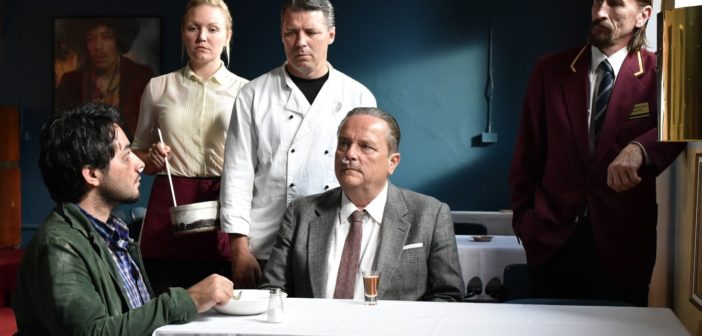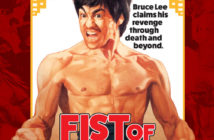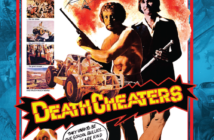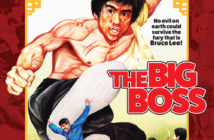I remember a film festival somewhere in the USA a few years ago where Iranian director Abbas Kiarastami was denied an entry visa by virtue of belonging to what Bush had dubbed a ‘rogue state’. Finnish director Aki Kaurismäki heard the news while he was waiting at the airport to attend the same film festival, and thought, ‘Fuck it, I’m not going either’, and proceeded to head home. This year the two directors were again linked at the Sydney Film Festival by virtue of the fact that the documentary about the late Iranian director, 78 Minutes and 15 Seconds with Abbas Kiarastami was shown, together with a delightful 16 minute short Take Me Home, which showed a football rolling down a seemingly endless array of stone alleys and steps in southern Italy, and finally being followed and retrieved by a young Iranian boy. Aki Kaurismäki’s latest, The Other Side of Hope, about a Syrian refugee in Helsinki, was also another highlight, of the festival, a film he dedicated to the late Finnish film critic Peter Von Bagh, the editor of the Finnish film magazine Filmhollu, and author of numerous books about Finnish cinema including one about Kaurismäki. The Kiarastami film had a woefully small audience, and it is to be hoped that this doesn’t mean the great Iranian director has already been forgotten, but the Kaurismäki marked my first experience in the opulent art deco Hayden Orpheum in Cremorne, a thoroughly suitable venue for this droll, elegant film, made on celluloid, which was packed.
I only managed to get to see ten films this year, but most were thoroughly worth seeing, although there were a couple of disappointments – most notably Michael Winterbottom’s documentary about the UK group Wolf Alice, On the Road an interminable rock doco with fictional elements which only served to make it more interminable. Wolf Alice, who borrowed their name from a short story from edgy black magic-oriented writer Angela Carter, who died in 1992, and are quite an interesting band with a female vocalist, tour the UK and Ireland, and every city they visit is duly recorded to the point that it becomes, ‘how many more places can I bear?’ Added to the clichéd ingredients are a fictional love story between Joe, a Glaswegian male roadie and Estelle, a photographer, who is seen nodding along to the band’s music. The original title was Love Story, which indicates how clichéd the whole concept was, although Peter Bradshaw in the Guardian described it as ‘[Winterbottom’s] best film in years’.
The other music doco I saw, Liberation Day recorded the first western rock group to play in North Korea, the Slovenian band Laibach, who performed their version of The Sound of Music, a potentially explosive combination which the film succeeded in making prosaic and tedious. It’s not such an unusual move for them, as they’ve already recorded their version of Jesus Christ Superstar and various national anthems, but the film shows hysterical US TV reactions to the event which make it sound like the most explosive news ever. I’ve long been a fan of Laibach, although the only time I saw them live was in New York in the 1990s, where they played in WW1 uniforms, and took an interminably long time to get started, after a series of drum rolls which went on for ever, and then a series of samey samples. But they have done some brilliant work, such as their cover version of the Beatles’ album Let it Be (without the title track) and this film included a lot of clips from videos and other documentaries they’ve made, most of them more interesting than this one. Their vocalist Ivo Saliger has an extraordinary basso profondo voice and can make the most innocuous material sound edgy and threatening, so The Sound of Music was fair game for a Laibach makeover.
When the film was premiered at the Amsterdam International Documentary Film Festival, the band gave a performance afterwards and Slovenian cultural theorist Slavoj Zizek was on hand to introduce it, and he makes a brief appearance in the film, saying that Laibach succeed in undermining democratic regimes with their over-identification with Fascist symbolism. There’s a whole book and numerous scholarly articles about the band on this theme of over-identification, given support by Zizek, who claims it’s deadly serious and not ironic as most left-wingers assume, it’s a beguiling conundrum. But the film is dominated by Norwegian director and entrepreneur Morten Traavik, who says in the film that this is his 15th trip to North Korea, and he’s obviously an expert in dealing with the entanglements of North Korean bureaucracy, and that is mostly what we get in this film, which takes place on the 70th anniversary of their liberation from South Korea – hence the title. There are encounters with a team of censors, who keep themselves hidden and anonymous, and veto parts of the show, and when we finally get to see the actual show, it consists of only one song – all the rest has been cut from the film, but not by the censors, and the audience response is very low-key and unsurprised, which may be in itself unsurprising after all the hoo-hah. The film starts with one of Laibach’s ‘10 Items of the Covenant’, stating ‘All art is subject to political manipulation, except for that which speaks the language of this same manipulation’ and in the end it’s hard to see who has been duped more – the audience or Laibach.
Maudie was a delightful Canadian film starring the always delightful English actress Sally Hawkins in the title role, although she is always referred to as ‘Maud’ in the film, so the diminutive seems redundant. Maud Lewis suffers from acute rheumatoid arthritis from early childhood, and is virtually imprisoned by her spinster aunt in rural Nova Scotia. She manages to break free when she sees an ad for a housekeeper posted by the taciturn, rather moronic fish merchant Everett Lewis (Ethan Hawke), who lives in a tiny house in a remote backlot. After a false start she succeeds in convincing Everett that he needs her, and despite having to share a bed with him, she starts painting greeting cards, which she sells to a chic woman from New York (Kari Matchett) for small change, and then to the local store. Meanwhile she is painting flowers, birds and animals on everything in sight, and transforms the cottage into an Aladdin’s cave, which soon starts to get media attention far and wide, and Maud becomes a celebrity, selling full-scale paintings from the cottage – she even sells one to Richard Nixon. Despite ranking Maud below horses, dogs and chickens, Everett reacts to this with some degree of generosity, even helping with the housework after a while to give Maude time to paint, and also reacting kindly to her revelation that she has had a pregnancy in her past, but the baby died. They get married, and she signs his name on her paintings. With a score by Cowboy Junkies guitarist Michael Timmins, direction by former TV director Aisling Walsh, and a screenplay by Sherry White, it’s a modest, low budget affair which totally avoids Hollywood sentimentality and is lit up by its star cast and its music. Everett even succeeds in tracking down Maud’s daughter – her family has lied to her as well as cutting her out of her inheritance – but Maud dies a relatively satisfied woman who achieves some happiness. The film ends with a clip from Diane Beaudry’s documentary ‘Maud Lewis: A World Without Shadows’, which was perhaps a mistake, as the real Maud is much frailer and more elderly than the comparatively glamorous Hawkins, although it is good to get a glimpse of the real person, again without the diminutive. A delightful antidote to Hollywood schmaltz that is well worth seeing.
Austrian director Michael Haneke’s Happy End is not quite up to the standard of his brilliant Hidden, but it comes pretty close. It’s a deliciously malicious satire of a French haute bourgeoise family starring Isabelle Huppert as Anne Laurent, who is about to be engaged to her English lawyer (Toby Jones), and has taken over the family construction and transport business from her doddering father (Jean-Louis Trintignant). Her no-hoper son Pierre (Franz Rogowski), is a drunk who has caused a site accident resulting in the death of a worker, and made the family liable for a civil law suit, and her brother Thomas (Mathieu Kassovitz) is having a lurid affair with a cellist, documented in emails. The delightfully evil 12 year old Ève (Fantine Harduin) has fed her mother’s anti-depressants to her pet hamster, and has also been reading her father’s Thomas’ emails to his mistress, which explains some of her awkward questions. The film’s denouement involves Ève, Grandpa and a wheelchair, and is a piece of blackly comic grand guignol. After the film, I sat next to two elderly ladies at Town Hall station, one wearing a rather intimidating eyepatch, who dismissed the film as simply ‘one scene cutting into another’ without much sense, but I think they could have been more observant.
Raoul Peck’s documentary I Am Not Your Negro takes James Baldwin’s unfinished 30 page manuscript Remember This House, a study of the deaths of black activists Medgar Evars, Malcolm X and Martin Luther King, as its starting point, with Baldwin voiced by Samuel M. Jackson. It reminded me how brilliant an orator Baldwin, who died in 1987, was, as well as a pioneering black writer who also happened to be gay. Baldwin is best when we hear him speaking his own words, as he does in sequences from the Cambridge Union Society, where he took part in a televised 1965 debate, ‘Has The American Dream Been Achieved At The Expense Of The American Negro’, and the Dick Cavett Show, where he politely demolishes a conservative US intellectual as Cavett squirms. We are reminded of Bobby Kennedy’s statement that the USA may have a black president in 40 years’ time, as well as the Rodney King episode, showing how little has changed. Bob Dylan’s song about Medgar Evers, ‘Only A Pawn in their Game’, is a suitable blast from the past, but it is Baldwin’s anger, eloquence and incisiveness that makes this film a brilliant document about race in the USA.
http://www.festival-cannes.com/en/festival/web-tv/trailer/sea-sorrow
Another documentary, Sea Sorrow this time about refugees, was the first film directed by Vanessa Redgrave, at the age of 80, who was on hand to present the film. It’s something of a propaganda essay, with Redgrave sometimes speaking to camera holding up a poster designed by her grand daughter with a shot of refugee children in the backgound. It’s obviously heartfelt, and shows scenes from the Jungle in Calais, with Redgrave going into her own experiences in WW2, when British people in the country accepted evacuees, and also referring to the efforts of the Labour peer Lord Dubs, who was on the Kindertransport as a child, to assist refugees. The title is a quote from Shakespeare’s Tempest, and Redgrave acts out a scene from the play with Ralph Fiennes, as well as making other Shakespearian references. It’s a slightly awkward film at times, but its heart is in the right place, and credit should also go to its producer Carlo Nero.
Afterimage is the great Polish director Andrej Wajda’s final film, finished just before his death in October 2016 at the age of 90, about internationally famous Polish constructivist painter Wladyslaw Strzeminski (Boguslaw Linda), an amputee who lost an arm and a leg in WW1. and an inspiration to many, who was stifled by the Stalinist regime and expelled from his position at the University of Lodz. The film is a companion piece to Wajda’s previous film, Katyn, about the 1940 massacre of 22,000 prominent men in Polish society, of which Wajda’s father was one, by Soviet secret police on Stalin’s orders. The Soviets then tried to shift the blame onto the Nazis, and that denial persisted until 1990. Afterimage was written by Andrzej Mularczyk, the author of the book on which Katyn was based, and although milder than the previous film, it is still a damning portrayal of the Stalinist regime from 1948 onwards. A key scene shows Strzeminski in his room about to start a painting when the entire room turns red, as it is covered by a huge banner dedicated to Stalin. He rips a hole in it with his crutch to let some light in, and is immediately pounced on by apparatchicks. A firm believer in abstract art and the autonomy of the artist, he is forced to get a job painting Stalinist posters, but he is sacked when his identity is revealed. At first his faithful students try to help him, but they can do little when they discover their careers will suffer. It’s a final statement from one of the world’s great directors who has been making films since the 1950s, when his Generation trilogy was released, and launched the career of Roman Polanski, and it is to be hoped that his memory will remain.
In the Fade (actually called In the Nothingness, Aus dem Nichts in German), is the latest film from Turkish German director Fatih Akin, director of the edgy Head-On, this time starring German-born Hollywood and French actress Diane Kruger as Katja, the late wife of a Turkish ex-drug dealer, Nuri Şekerci (Numan Acar) and her six-year-old son Rocco (Rafael Santana), who are killed in a bomb attack by neo-Nazis in Hamburg while she is out at a spa with a girlfriend. Katja then attempts suicide in the bath, but is revived by the voice of her lawyer, telling her that the couple involved have been arrested. Katja has spoken to the suspected female bomber outside her husband’s office just prior to the attack, and the film develops into a standard courtroom drama, in which a reptilian lawyer manages to get the couple off the charges through lack of evidence. This involves evidence from an equally reptilian Greek with fascist connections, and Katja tracks the couple down to their holiday vehicle in Greece with disastrous consequences. The film maintains tension throughout, and is damning of the court’s fascist sympathies as well as gripping – a return to form for Akin.
Aki Kaurismäki’s latest film, The Other Side of Hope is also about refugees, like his previous film Le Havre, although he is more leisurely in his film making these days, taking a much longer time between films. But unlike Le Havre, The Other Side of Hope is back on his home terrain in Helsinki, and features a few local musicians providing interludes along the way, as well as the protagonist playing the oud. Khaled (Sherwan Haji, a guest at the festival) is a mechanic from Syria who stows away from Aleppo and ends up in Helsinki in the hold of a container ship which is full of coal, in which he hides himself, and has remains of it all over him when he comes ashore. Meanwhile, in a parallel plot, Waldemar Wikström (Sakari Kuosmanen), whose marriage has disintegrated, is tired of his life as a shirt salesman, and ventures into a casino, where he strikes paydirt at poker. He decides to buy a restaurant, which takes us back into Kaurismäki’s earlier film, Floating Clouds, territory, with a similarly deadpan staff on hand to greet the new boss. He also encounters Khaled, and they come to blows before Wikström recruits him as a kitchen hand. After he is forgotten in the bathroom with the ever-present Kaurismäki dog during a raid by inspectors, Khaled receives more attention in the restaurant, and even survives a disastrous experimental shift to a sushi bar. The film maintains Kaurismäki’s droll, deadpan style, even when Khaled is deported, but manages to break a window in the detention centre and escape. He is then persecuted and injured by fascist white power bullies in a car park who ignorantly call him ‘Jewboy’, and although at first rescued by derelicts, he is later stabbed, and left to an uncertain fate. Kaurismäki’s humanitarian sympathies are ever present without ever becoming sentimental, and his characteristic humour is also present in this bleak but always hopeful story. It’s a suitable end for a festival which inevitably highlighted the plight of refugees and showed up the crass inhumanity of the Australian government. It’s also a good place for me to sign off in my European summer base in Helsinki.




